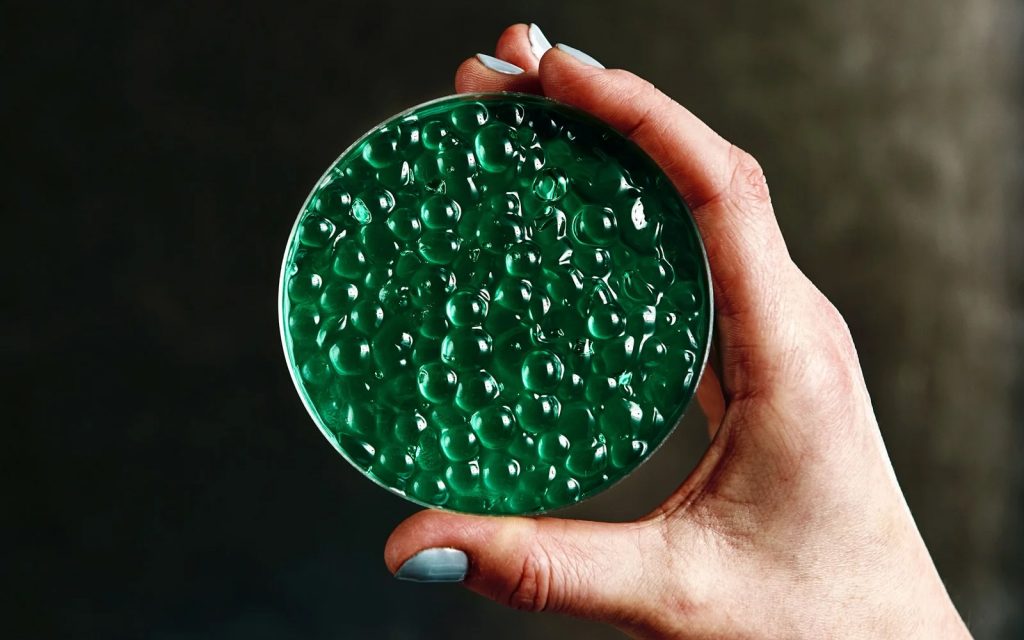Link About It: This Week’s Picks
Innovation in space food and slime, an artist’s sudden success, and why we should eat more sea urchins

The Future of Space Food
 MIT Media Lab’s Space Exploration Initiative focuses on all kinds of research and preparation for “the day when humanity becomes a space-native civilization, as comfortable in thFrom slime to space, tech and textilese cosmos as we have been on Earth.” The team (made up of 50+ graduate students, staff, scientists, designers, and engineers) works on countless aspects of space travel, but hones in on two central topics: boredom and food. These entities will be inextricably linked on a nine-month trip to Mars. Industrial designer Maggie Coblentz, who leads gastronomic research, tells Nicola Twilley for Wired, “Humanity’s off-world survival will depend on a diet that can nourish not only travelers’ bodies but their minds and souls.” From changes in the human digestive system in space, to preparation, food packaging, size, weight, the dangers of weightlessness (like choking) and more, the team does remarkable work exploring options—which may include Pop Rocks and algae-based “caviar.” Read the full article at Wired.
MIT Media Lab’s Space Exploration Initiative focuses on all kinds of research and preparation for “the day when humanity becomes a space-native civilization, as comfortable in thFrom slime to space, tech and textilese cosmos as we have been on Earth.” The team (made up of 50+ graduate students, staff, scientists, designers, and engineers) works on countless aspects of space travel, but hones in on two central topics: boredom and food. These entities will be inextricably linked on a nine-month trip to Mars. Industrial designer Maggie Coblentz, who leads gastronomic research, tells Nicola Twilley for Wired, “Humanity’s off-world survival will depend on a diet that can nourish not only travelers’ bodies but their minds and souls.” From changes in the human digestive system in space, to preparation, food packaging, size, weight, the dangers of weightlessness (like choking) and more, the team does remarkable work exploring options—which may include Pop Rocks and algae-based “caviar.” Read the full article at Wired.
Artist Luchita Hurtado’s Sudden Success at 99
 Venezeula-born, California-based artist Luchita Hurtado’s success at 99 years old came rather late (she’s been painting since the 1940s) and somewhat unintentionally, but she’s embraced it. For many years, she was known as an artist’s wife (she was married to Austrian surrealist Wolfgang Paalen, then American painter Lee Mullican, with whom she has a son, artist Matt Mullican) and spent “decades cheering them on while quietly creating her own work.” But now her show I Live I Die I Will Be Reborn will be opening at LACMA (16 February) before heading to Mexico City’s Tamayo Museum. Because she had barely shown her work publicly, Hurtado was immensely free to explore her talent, and her style bounces between abstract and portraiture, experimenting with lettering, Navajo-inspired pattern work and more. “I’d forgotten a lot of what I’d done,” she tells The Wall Street Journal. “I didn’t find them interesting at the time, but now I do.” Read more at WSJ.
Venezeula-born, California-based artist Luchita Hurtado’s success at 99 years old came rather late (she’s been painting since the 1940s) and somewhat unintentionally, but she’s embraced it. For many years, she was known as an artist’s wife (she was married to Austrian surrealist Wolfgang Paalen, then American painter Lee Mullican, with whom she has a son, artist Matt Mullican) and spent “decades cheering them on while quietly creating her own work.” But now her show I Live I Die I Will Be Reborn will be opening at LACMA (16 February) before heading to Mexico City’s Tamayo Museum. Because she had barely shown her work publicly, Hurtado was immensely free to explore her talent, and her style bounces between abstract and portraiture, experimenting with lettering, Navajo-inspired pattern work and more. “I’d forgotten a lot of what I’d done,” she tells The Wall Street Journal. “I didn’t find them interesting at the time, but now I do.” Read more at WSJ.
Scoby Slime a Sustainable, Edible Packaging Possibility
 As single-use plastic waste continues to pile up, packaging solutions comprised of alternative materials are in high demand. While recycled material offers an opportunity for adaptive reuse, options that are naturally available could provide even more sustainable solutions. Scoby, an edible and natural byproduct of the process of fermenting kombucha, could be a zero-waste option for packaging dry and semi-dry goods. Polish designer Roza Janusz popularized the slime’s potential, and her process—which is scalable but takes around two weeks and requires the addition of vegetable-based agricultural waste to the base bacteria and yeast—can be replicated anywhere. Additionally, used Scoby can be re-entered into the circular system along the way. Read more at OneZero.
As single-use plastic waste continues to pile up, packaging solutions comprised of alternative materials are in high demand. While recycled material offers an opportunity for adaptive reuse, options that are naturally available could provide even more sustainable solutions. Scoby, an edible and natural byproduct of the process of fermenting kombucha, could be a zero-waste option for packaging dry and semi-dry goods. Polish designer Roza Janusz popularized the slime’s potential, and her process—which is scalable but takes around two weeks and requires the addition of vegetable-based agricultural waste to the base bacteria and yeast—can be replicated anywhere. Additionally, used Scoby can be re-entered into the circular system along the way. Read more at OneZero.
Space Engineer Justine Haupt’s DIY Rotary Cell Phone
 In an attempt to remedy the harm of an always-on lifestyle, Brookhaven National Laboratory astronomy instrumentation engineer Justine Haupt stripped a mobile phone down to its essentials in order to assemble her handheld rotary cellphone. For the DIY invention, three years in the making, Haupt paired a rotary mechanism from an old Trimline telephone with a microcontroller and Adafruit Fona 3G cell transceiver. She then housed it all in a 3D-printed case. The “perfectly usable” phone makes and receives calls. Read more about it within Haupt’s interview with Wired.
In an attempt to remedy the harm of an always-on lifestyle, Brookhaven National Laboratory astronomy instrumentation engineer Justine Haupt stripped a mobile phone down to its essentials in order to assemble her handheld rotary cellphone. For the DIY invention, three years in the making, Haupt paired a rotary mechanism from an old Trimline telephone with a microcontroller and Adafruit Fona 3G cell transceiver. She then housed it all in a 3D-printed case. The “perfectly usable” phone makes and receives calls. Read more about it within Haupt’s interview with Wired.
Eating Sea Urchins Could Restore the Ocean’s Ecosystem
 Contrary to reports that conservation is the only way to save our oceans, one company’s hypothesis suggests that eating more sea urchins (urchin roe or uni in Japanese) could actually help restore balance in the aquatic ecosystem. Urchinomics (the aptly named organization testing this theory) found urchins thriving in waters now abandoned by predators due to pollution, heating or overfishing. Increased urchin populations means trouble for kelp forests, which act as the ocean carbon filter but are also devoured by hungry urchins. To restore the forests, Urchinomics suggests moving the excess urchins to on-lands farm where they’re fed—it takes a minimal amount of all-natural feed for urchins to grow—and harvested for human consumption. Removing the rampant population from the ocean will allow for regeneration of the ocean’s broader ecosystem, and restaurant-quality uni at a more affordable price point. Read more at TreeHugger.
Contrary to reports that conservation is the only way to save our oceans, one company’s hypothesis suggests that eating more sea urchins (urchin roe or uni in Japanese) could actually help restore balance in the aquatic ecosystem. Urchinomics (the aptly named organization testing this theory) found urchins thriving in waters now abandoned by predators due to pollution, heating or overfishing. Increased urchin populations means trouble for kelp forests, which act as the ocean carbon filter but are also devoured by hungry urchins. To restore the forests, Urchinomics suggests moving the excess urchins to on-lands farm where they’re fed—it takes a minimal amount of all-natural feed for urchins to grow—and harvested for human consumption. Removing the rampant population from the ocean will allow for regeneration of the ocean’s broader ecosystem, and restaurant-quality uni at a more affordable price point. Read more at TreeHugger.
Marvin’s Innovations For Improved Natural Light and Air Access
 Relying on its long-standing history as one of the most reliable brands in the home and interiors markets, Marvin is introducing two innovative new products at 2020 International Builders’ Show that reference their abilities, but also test their potential. Skycove is a prefab, pop-out window-box designed to expand interior square footage and seating, while Awaken is a smart skylight that can dim natural sunlight, purify incoming air and close automatically when it identifies rainfall. Each requires little assembly aside from installation, and emphasize interior design’s ability to influence overall wellbeing—especially our connection to the outdoors, natural light and air quality. Read more at Markets Insider.
Relying on its long-standing history as one of the most reliable brands in the home and interiors markets, Marvin is introducing two innovative new products at 2020 International Builders’ Show that reference their abilities, but also test their potential. Skycove is a prefab, pop-out window-box designed to expand interior square footage and seating, while Awaken is a smart skylight that can dim natural sunlight, purify incoming air and close automatically when it identifies rainfall. Each requires little assembly aside from installation, and emphasize interior design’s ability to influence overall wellbeing—especially our connection to the outdoors, natural light and air quality. Read more at Markets Insider.
Link About It is our filtered look at the web, shared daily in Link and on social media, and rounded up every Saturday morning.











